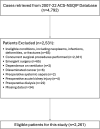The Impact of Body Mass Index and Metabolic Syndrome on Perioperative Outcomes Following Cervical Laminoplasty
- PMID: 40479528
- PMCID: PMC12144038
- DOI: 10.1177/21925682251349993
The Impact of Body Mass Index and Metabolic Syndrome on Perioperative Outcomes Following Cervical Laminoplasty
Abstract
Study DesignRetrospective cohort study.ObjectivesObesity and metabolic syndrome have become a common comorbidity among patients undergoing spine surgery. This study aimed to evaluate 30-day postoperative outcomes following cervical laminoplasty, stratified by BMI categories and the presence of metabolic syndrome.MethodsThis study utilized the 2007-2022 ACS-NSQIP database. Patients who underwent cervical laminoplasty were identified and categorized into six BMI groups, according to the World Health Organization guidelines, and based on the presence of metabolic syndrome. The primary outcome was the 30-day occurrence of at least one complication (excluding blood transfusions). Secondary outcomes included rates of complications, hospital length of stay, and total operative time.ResultsA total of 2261 patients were analyzed, including 21 underweight, 510 normal-weight, 782 pre-obese, 565 class I obese, 249 class II obese, and 134 class III obese individuals. The cohort consisted of only 244 individuals with metabolic syndrome. Class II obesity (coefficient 23.585, 95% CI 10.815-36.355; P < 0.001) and class III obesity (coefficient 20.096, 95% CI 4.712-35.479; P = 0.011) were independently associated with longer operative times. Metabolic syndrome was an independent risk factor for deep incisional SSI (OR 3.25, 95% CI 1.07-9.80, P = 0.037), postoperative pneumonia (OR 4.17, 95% CI 1.63-10.63, P = 0.003), and prolonged hospitalization (OR 1.68, 95% CI 1.17-2.41, P = 0.005).ConclusionsPatients with metabolic syndrome face an increased risk of adverse outcomes after cervical laminoplasty. Implementing preoperative preventive interventions may help mitigate complications and associated costs in these patients. Furthermore, preoperative weight loss in class II-III obese patients may help decrease operative time and associated costs.
Keywords: body mass index; cervical vertebra; laminoplasty; metabolic syndrome; obesity; postoperative complication; thinness.
Conflict of interest statement
The author(s) declared the following potential conflicts of interest with respect to the research, authorship, and/or publication of this article: The authors report no conflict of interest or funding source. American College of Surgeons National Surgical Quality Improvement Program (ACS NSQIP) and the hospitals participating in the ACS NSQIP are the sources of the data used herein; They have not verified and are not responsible for the statistical validity of the data analysis or the conclusions derived by the authors.
Figures
Similar articles
-
Anterior and posterior cervical fusion in patients with high body mass index are not associated with greater complications.Spine J. 2014 Aug 1;14(8):1643-53. doi: 10.1016/j.spinee.2013.09.054. Epub 2013 Oct 24. Spine J. 2014. PMID: 24388595
-
Obese Class III patients at significantly greater risk of multiple complications after lumbar surgery: an analysis of 10,387 patients in the ACS NSQIP database.Spine J. 2014 Sep 1;14(9):2008-18. doi: 10.1016/j.spinee.2013.11.047. Epub 2013 Dec 6. Spine J. 2014. PMID: 24316118
-
Impact of body mass index on surgical outcomes, narcotics consumption, and hospital costs following anterior cervical discectomy and fusion.J Neurosurg Spine. 2018 Feb;28(2):160-166. doi: 10.3171/2017.6.SPINE17288. Epub 2017 Dec 1. J Neurosurg Spine. 2018. PMID: 29192877
-
Perioperative Complications and Radiographic Outcomes Following Cervical Laminoplasty: A Review of 105 Cases from a Single Academic Center.World Neurosurg. 2023 Dec;180:e258-e265. doi: 10.1016/j.wneu.2023.09.049. Epub 2023 Sep 20. World Neurosurg. 2023. PMID: 37739170 Review.
-
Comparison of clinical outcomes and safety between laminectomy with instrumented fusion versus laminoplasty for the treatment of multilevel cervical spondylotic myelopathy.Medicine (Baltimore). 2019 Feb;98(8):e14651. doi: 10.1097/MD.0000000000014651. Medicine (Baltimore). 2019. PMID: 30813208 Free PMC article.
References
LinkOut - more resources
Full Text Sources



